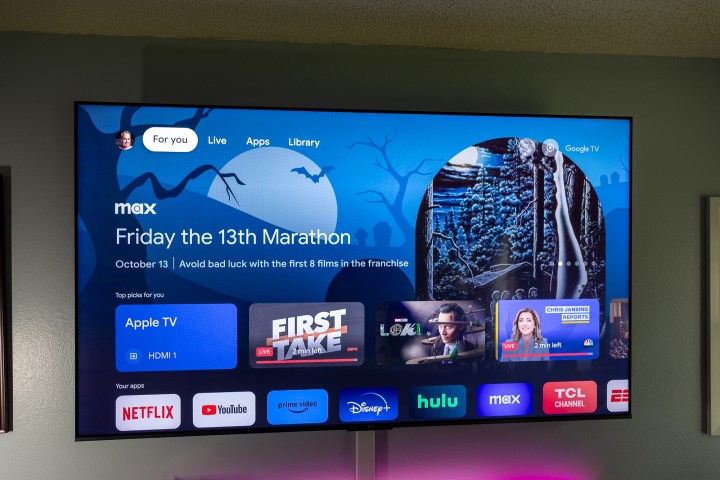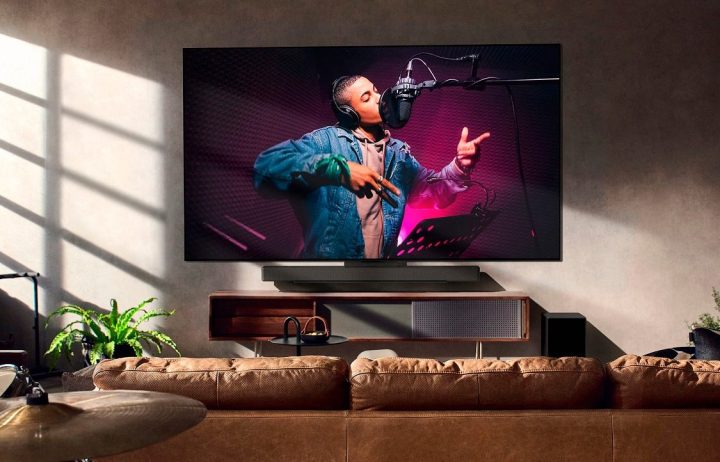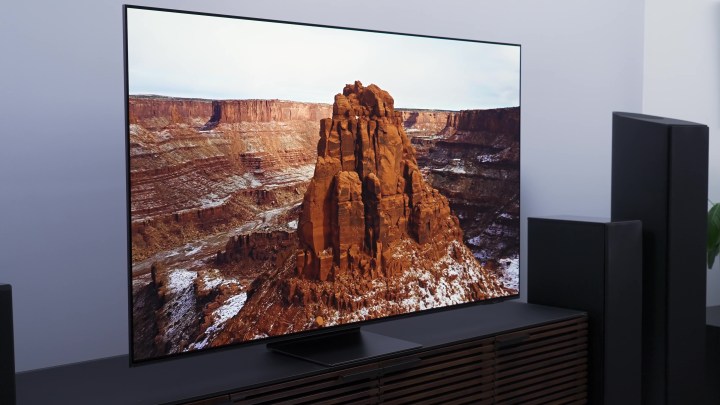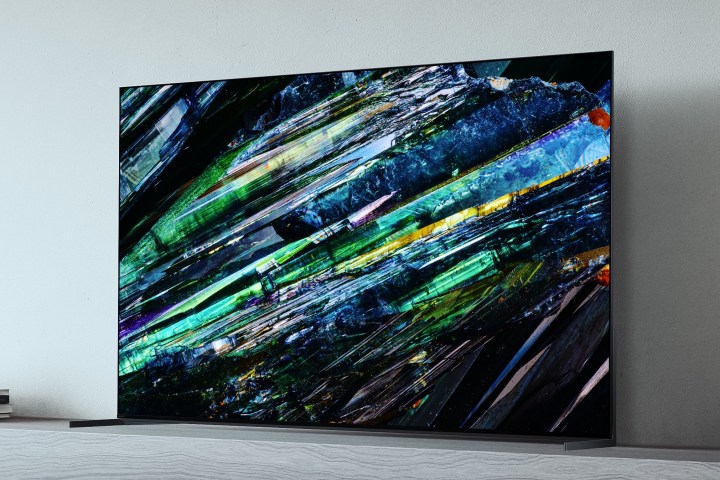Zeke Jones / Digital Trends
We live in a world of cutting-edge TVs from big brands like Samsung, Sony, LG, Hisense, and TCL. By extension, this also means we get to live in a world of mesmerizing gaming tech. You see, video game consoles like the PlayStation 5 and Xbox Series X/S are engineered to deliver exceptional video and audio to your TV. And thanks to 4K resolution, HDR, and gaming-optimized picture settings, your video games can look and sound better than they ever have.
If you’re a dedicated gamer, you want to make sure you’re investing in a TV that will make your console and PC gaming truly shine. Fortunately, we know a thing or two when it comes to AV devices, and we’ve tested a lot of the best TVs of 2024 ourselves. To that end, we’ve gone ahead and built this best gaming TVs roundup to help you pick out a set that lines up with your specific wants and needs.

Zeke Jones / Digital Trends
Sony Bravia 9 Series
The best gaming TV this year
Pros
- Super-clean picture
- Deep blacks, minimal blooming
- Excellent contrast
- Searing HDR highlights
- Excellent motion handling
Cons
- Backlight fluctuations visible in dark rooms
- Very expensive
New to 2024, the Sony Bravia 9 Series is not only the company’s flagship set of the year but it’s also one of the best TVs you can play video games on, bar none. According to Sony, microcosmic LED controllers allow the Bravia 9 to achieve the kind of contrast accuracy and inky black levels usually associated with the best OLED TVs. We loved what we saw (and heard) in our hands-on review of this mini-LED set, but how exactly does the Bravia 9 fare against input lag and demanding online gameplay? Quite nicely, though there is a slight caveat. We’ll let our editor-at-large Caleb Denison, shine some light on the matter:
“[The Sony Bravia 9 Series] doesn’t do 144Hz refresh rate, so it isn’t perhaps going to unlock that one feature for those using high-end gaming PCs. But it does support VRR, ALLM, and source-based tone mapping, so it’s a great companion to both of the Xbox and PlayStation 5 consoles.”
Beyond that 144Hz limitation, though, each of the Bravia 9’s four HDMI ports is HDMI 2.1 certified, ensuring you’ll get the absolute best motion and lag performance when connecting a modern console. And thanks to the chart-topping illumination this mini-LED monolith can achieve and the set’s excellent reflection handling, you should have zero issues gaming in a brightly lit room.
Oh, and the Bravia 9 is an absolute champ when it comes to support for class-leading codecs like Dolby Vision and Dolby Atmos. We’re also glad to report that the sound on this TV isn’t half-bad either, though home theater diehards and gaming enthusiasts may prefer a soundbar, surround system, or gaming headset.

Sony Bravia 9 Series
The best gaming TV this year

Best Buy
Hisense U6N LED
Best budget-friendly TV for gaming
Pros
- Solid gaming optimizations
- Great HDR support
- Nice SDR brightness, colors, and contrast
Cons
- No HDMI 2.1 support
- Not the best off-angle performance
- Default picture settings are not very good
Similar to the TCL Q6 Series, the Hisense U6N (the successor to the Hisense U6K of 2023) is a fantastic entry-level QLED TV for gaming. Yes, we know Hisense likes to say “ULED,” but that’s just the company’s way of telling you that the U6N feature uses LED lighting and quantum dots. As to the latter, these chemical compounds are used to enhance peak brightness levels and overall color and contrast details, especially when playing games in HDR. The real big wins with the U6N model, though, are its gameplay performance and rock-bottom price.
Thanks to its automated PC/Game Mode, the Hisense U6N delivers the kind of lag-free visuals and mechanics usually reserved for TVs with HDMI 2.1 ports (unfortunately, you won’t find those here). You’ll also be able to take advantage of VRR support; although this does limit the resolution and refresh rate to 4K@60Hz. One nice workaround is you can choose to disable VRR to game at up to 1440p@120Hz (or 1080p@120Hz).
When gaming in HDR, total brightness is slightly reduced, so the U6N may not hold up super well in brightly lit rooms. It also tends to have some struggles with off-angle viewing, so your best bet is to sit as centered with the screen as possible. Those few considerations aside, though, the Hisense U6N is one of the best budget-friendly TVs for gaming, and it’s also great for watching movies and TV shows, as well as for streaming apps like Disney+ and Netflix.

Hisense U6N LED
Best budget-friendly TV for gaming

Phil Nickinson / Digital Trends
TCL Q6 Series QLED
The runner-up budget gaming TV
Pros
- Great value
- Google TV built-in
- Easy to use
- Decent remote control
Cons
- Panel quality matches the price
- Remote not backlit
- Bloatware in the operating system
The TCL Q6 Series is the bottom rung on TCL’s flagship ladder (with the Q7 and QM8 representing the higher rungs). In terms of HDMI inputs, you’ll be working with three 2.0 ports. All three of these inputs also support VRR, but the real win with the Q6 is the set’s incredibly low input lag. This is particularly relevant for competitive gamers who can’t miss a beat during an online match.
The Q6 Series also does a great job at handling both HDR and SDR performance. The former delivers gameplay imagery that is nice and vibrant, while the latter amps up the peak brightness even more. If you’re going to be doing a majority of your gaming in a well-lit room, it’s important that your TV can get bright enough to beat the sunlight and whatever ambient fixtures are contributing luminance. Fortunately, the Q6 also happens to have good reflection handling, so even if the screen is a little on the dark side, you shouldn’t see much in the way of glare.
One thing that’s missing on the Q6 Series though is local dimming, and the set’s native refresh rate is only 60Hz. While TCL attempts to counter this with the Game Accelerator 120 (picture processing that makes 60Hz look more like 120Hz), the TV’s overall response time still takes a hit because of this.
But if you’re looking to save a few bucks on your TV purchase, and want a gaming set that satisfies several must-haves for offline and online gameplay, the TCL Q6 Series should definitely be a consideration.

TCL Q6 Series QLED
The runner-up budget gaming TV

LG
LG C3 OLED
An excellent midrange gaming TV
Pros
- Amazing brightness
- Beautiful color and inky blacks
- HDMI 2.1 support
- Automated game mode
Cons
- Brightness suffers in game mode
When it comes to OLED TVs, LG has made quite the name for itself over the last several years. This is to the point where companies like Samsung are buying its OLED TV screens directly from LG Display. If we made our own OLEDs, we’d probably do the same.
As far as gaming goes, we’re more than glad to call the LG C3 one of our go-to models in the upper midrange category. For a couple of years now, LG has been developing and implementing brighter OLED screens (called Evo panels) on many of its higher-end models, along with a feature called Brightness Booster that adds extra peak and color brightness all around. When you combine this enhanced illumination with the already-astonishing color gamut and inky blacks of an LG OLED, you’re left with a stunning picture that is perfect for console and PC gaming.
With HDMI 2.1 support across all four of the C3’s inputs, we expect big things when it comes to lag, response time, and overall motion handling. Thankfully, LG more than delivers on all these fronts, and the addition of an automated Game Mode optimizes the colors and contrast for whatever you’re playing even further.
Admittedly, your overall HDR brightness takes a bit of a hit when Game Mode is engaged. But the C3 is also no straggler when it comes to reflection handling, so even if you’re dealing with some extra sunlight, the rays shouldn’t affect your gameplay experience too drastically.

LG C3 OLED
An excellent midrange gaming TV

Zeke Jones/Digital Trends / Digital Trends
Samsung S95C QD-OLED
Toeing the line between midrange and premium
Pros
- Incredibly bright colors
- Perfect black levels
- Pristine overall picture
- Great upscaling
- Awesome for gaming
Cons
- Mediocre sound
- No Dolby Vision support
Welcome to the world of flagship gaming TVs, where the prices may be high, but the picture and performance is literally impossible to beat. We have two contenders in this final category, and the first on our list is a premium powerhouse known as the Samsung S95C OLED.
Have you ever heard of QD-OLED TVs? This is a relatively new display tech that you can find from brands like Samsung and Sony, although both companies seem to be doing away with the “QD” portion of the moniker these days. Regardless, the acronym stands for “Quantum Dot-Organic Light Emitting Diode.”
The Samsung S95C just so happens to be a QD-OLED, and is equipped with not only a full layer of quantum dots for enhanced brightness and colors, but also uses an OLED panel with millions of self-emissive pixels that can be toggled on or off in an instant. That’s on top of Samsung’s Neural Quantum Processor 4K that automatically upscales and calibrates picture quality on a frame-by-frame basis. But what about pure gaming tech, you may be asking?
Well friends, each of the S95C’s four HDMI inputs are 2.1 certified, meaning you’ll be able to enjoy Playstation, Xbox, and PC gaming in full 4K HDR at up to 120Hz, and up to 144Hz for compatible PCs. And thanks to ultra-low input lag and response time, the S95C delivers blistering-fast motion without devolving into blurry images. And while we wish the TV supported Dolby Vision, HDR10 and HDR10+ gameplay looks terrific.

Samsung S95C QD-OLED
Toeing the line between midrange and premium

Zeke Jones / Digital Trends
Samsung S95D QD-OLED
Best gaming TV for bright rooms
Pros
- Exellent brightness
- Eye-popping color
- Snappy operation
- Great gaming features
- Awesome for bright rooms
Cons
- Anti-glare treatment is polarizing
- Blacks may appear lifted in bright rooms
In our review, we called the 2024 Samsung S95D “one hell of a TV, one of the brightest — and definitely one of the best of the year.” We also explained the uproar the TV caused when it was revealed at this year’s CES, which centered on it’s anti-glare feature.
The technology reduces ambient light reflecting off the screen by spreading it across its surface. This helps create a more comfortable viewing experience, especially in bright rooms where traditional OLEDs often struggle. However, some people prefer a more localized effect, as the dispersion affects the entire screen, unlike on most other TVs.
But whether you care about the S95D’s anti-glare tech or not, it’s included on this list because of its excellent performance in brightly lit rooms, as well as its excellent gaming specs. Gamers will love the S95D’s lag-free and smooth gameplay thanks to the QD-OLED’s 144Hz refresh rate. It also features AMD’s FreeSync Premium Pro and Auto Low Latency (ALLM) gaming mode that automatically switches the TV to this setting when a game console is detected. And if you don’t have a console, that’s OK, too — because it’s a Samsung, it features Sammy’s Gaming Hub that allows you to play a ton of games from Xbox and other online cloud streaming game services.
Of course, when you’re done laying waste to your enemies, you’re also getting one of the best TVs of the year to watch movies and TV shows on. The flagship S95D benefits from Samsung’s latest NQ4 AI Gen2 Processor, and supports HDR10+, as well as Dolby Atmos sound for immersive audio.

Samsung S95D QD-OLED
Best gaming TV for bright rooms

Sony
Sony XR A95L QD-OLED
Another great premium gaming TV
Pros
- Best-in-class image processing
- Excellent brightness, contrast, and color
- Speedy 120Hz refresh af 4K
Our other top pick for gaming TVs in 2023 has to go to the godlike Sony XR A95L. Available in 55, 65, and 77-inch sizes, this is another QD-OLED set that employs quantum dots and self-emissive pixels, with a healthy dash of Sony’s Cognitive Processor XR thrown in for some of the best picture processing and upscaling in town.
As you can guess from our writeup on the Samsung S95C, the QD-OLED results are simply amazing. We’re talking incredible peak brightness levels, rich colors, unbelievable contrast, and lightning-fast motion handling for the A95L. But beyond the flagship features that we most certainly expect from a TV that starts pricing at $2,800, what impeccable gaming tech can we anticipate from this bad boy?
Well for starters, like the midrange Sony XR X93L, the A95L model is optimized for Playstation 5 gameplay. Two of the TV’s four HDMI inputs are 2.1 certified, with support for 4K at up to 120Hz. To further buttress the motion handling, the A95L also includes support for VRR and ALLM, ensuring you’ll experience as little lag as possible when playing online or offline.
But perhaps our favorite A95L gaming feature is the set’s Auto HDR Tone Mapping. This is a feature you’ll enable during the initial setup of your PS5 with the A95L. Once activated, all of your gameplay visuals will receive full HDR treatment (as long as the actual game is available in HDR), giving you the best brightness, colors, and contrast, regardless of the genre.
The Sony XR A95L also supports Multi-View, which lets you game on one part of the TV screen, while the second half of the screen can be used to stream a movie or show from apps like YouTube, Netflix, and Prime Video. And like many of the models in this roundup, the A95L comes with a gaming dashboard that lets you adjust things like motion clarity and picture presets without having to go into the TV’s main settings menu.

Sony XR A95L QD-OLED
Another great premium gaming TV
Frequently Asked Questions
How we choose the best gaming TVs
Before we sign off, we thought we’d go over how we’ve come up with these entries, and what’s important to us when selecting a gaming TV.
The first thing we look for is low input lag. Because if there’s too much delay between the action of your thumbs and the action on screen, well, that’s just a frustration nobody needs. Plus, it can be a huge disadvantage in competitive gameplay, where a few milliseconds literally can be the difference between a win or a loss.
Next, we look for solid picture quality in the TV’s “game mode” preset, which is what you’ll want to use for the lowest input lag. The picture quality doesn’t have to be videophile-grade awesome, but it can’t be trash, either. Today’s game graphics are gorgeous, and you deserve all that gorgeousness, so we seek to find the best balance between low input lag and awesome picture.
Then we need to see great motion resolution. We don’t have to have 120Hz native panels for good motion resolution. A 60Hz TV can look good, but, not all of them do, so we want to make sure we see as little blurring and stutter as possible for the best clarity during fast-moving gameplay.
But since we mentioned 120Hz, that definitely is nice to have, along with some other advanced gaming features like variable refresh rate (VRR), auto-game mode, Dolby Vision gaming, and maybe even up to a 144Hz refresh rate in some cases. We also want to make sure that these TVs do a nice job at displaying both HDR and SDR gaming content.
What are important things to look for with a gaming TV?
While you could most likely get away with using any of the best TVs on the market for your gaming needs, there are a few boxes to tick off when deciding. First, you’re going to want to look for a TV with a low input lag — this is the time it takes for that gameplay video signal to run from your game console to your TV’s HDMI port. Measured in milliseconds (ms), you want this to be as low as you can afford (some of the best TVs clock in around the 5ms range).
Of course, you want the TVs color, resolution, and brightness to be on point no matter what you’re using your TV for, but another important element for gaming is making sure it has HDMI 2.1 inputs to ensure the best experience. This latests HDMI technology will make sure you can take advantage of the latest gaming features such as variable refresh rate (VRR) — this includes AMD’s FreeSync and Nvidia’s G-Sync — as well as the latest refresh rates such as 144Hz and 120Hz.

